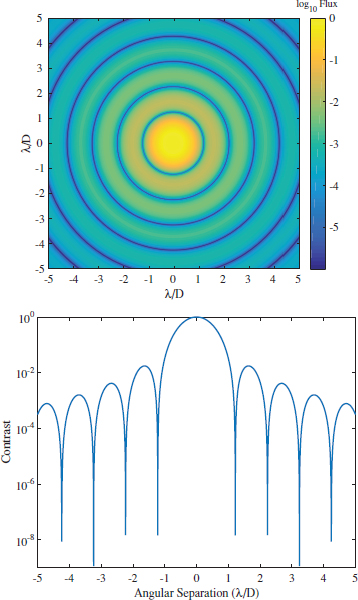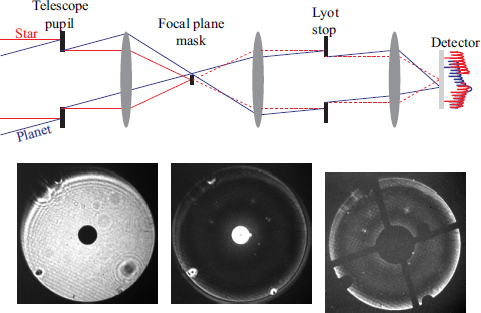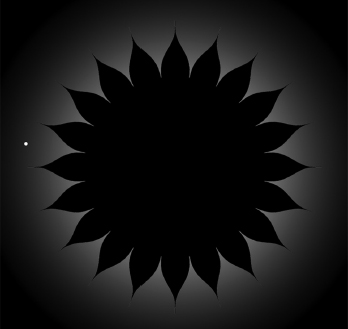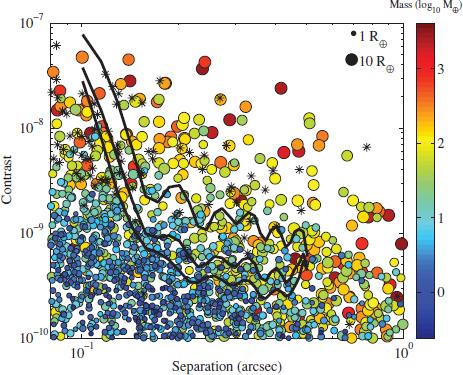Starlight Suppression: Technologies for Direct Imaging of Exoplanets
DMITRY SAVRANSKY
Cornell University
Of the nearly 2,000 planets confirmed to exist outside the solar system, only a handful were detected directly rather than inferred from their interaction with the stars they orbit. The vast majority were discovered by sifting years of observations of thousands of stars for periodic changes in the stars’ colors or fluxes, which indicate an orbiting planet.
Imaging allows for planetary detection with just one observation and confirmation with a few observations taken only months apart. More importantly, it enables spectroscopic characterization of exoplanets, often at spectral resolutions significantly exceeding those possible with any other detection method. With spectroscopy it is possible to probe the atmospheric and, potentially, surface composition of exoplanets and to validate models of planet formation and evolution.
Imaging is therefore a crucial component of exoplanet detection and characterization. Exoplanet imagers in ground observatories are already producing exciting discoveries (Macintosh et al. 2015), and the next generation of space instrumentation has the potential to detect Earth-like planets and indications of the presence of life.
This short paper reviews the challenges of exoplanet imaging, techniques used to overcome them, and the status of technology development for exoplanet imagers in space.
IMAGING OF EXOPLANETS
A telescope operates by collecting light from an astronomical source using a finite-sized aperture—either the entrance pupil of a refractive system or the primary mirror of a reflective one—and bringing the light to a focus on an imag-
ing detector, such as a charge-coupled device (CCD). Diffraction effects limit the spatial resolving capabilities of telescopes, with angular resolution inversely proportional to the size of the aperture. For a circular pupil the minimum angular resolution (αr) of the system will be greater than approximately 1.22λ/D, where λ is the wavelength of light and D the diameter of the aperture. This is most easily understood by considering the point spread function (PSF) of the telescope—the impulse response generated by imaging a point source.
For a circular aperture, the PSF is an Airy disk, shown in Figure 1—a bright central spot of radius αr surrounded by a series of annuli that decrease exponentially in brightness with angular separation. Between these annuli are small, dark regions called nulls.
Planets are significantly fainter than their host stars, with contrasts of 106 for the very brightest, self-luminous, young Jovian planets, and 1010 for Earth-sized planets in reflected visible light. Even if it were possible to observe a planet when it was precisely located on one of the deeper nulls of a perfect, diffraction-limited telescope, it would still not be possible to image it, because no detector has the dynamic range required to capture both the signals from the planet and the PSF of the star in the same image.
CORONAGRAPHY
Fortunately, this problem was partially solved in the early 20th century by solar astronomers studying the sun’s corona, which is 1 million times fainter than the sun itself. Previously, the corona could be studied only during full solar eclipses. In the 1930s, however, Bernard Lyot demonstrated the first solar coronagraph—a system designed specifically to block bright, on-axis sources and thus enable the study of faint, off-axis ones (Lyot 1939).
Figure 2 shows a schematic view of a Lyot (pron. Lee-o’) coronagraph, along with images taken at the pupil of a coronagraphic system. The pupil is conjugate with the entrance pupil of the whole system, so that the first image, where no coronagraph elements are in place, is equivalent to the intensity distribution seen by the entrance aperture of the whole system. The central dark spot in the first image is due to the secondary mirror that partially obscures the primary aperture in this system. On-axis starlight, together with off-axis planet light, enters the telescope and is brought to a focus where the on-axis source is blocked by a small, hard-edged focal plane mask (FPM). The remaining light is propagated to the next pupil plane (middle image). Most of the starlight is blocked by the FPM, but some will diffract around the mask’s edges, creating a pattern of rings along with a bright central spot. The remaining light is blocked by introducing another hard-edged mask, called a Lyot stop, into the pupil, leaving very little residual light, as shown in the image on the right. The Lyot stop can also include additional features to handle diffraction about other mechanical elements, such as struts that hold up the secondary mirror.

FIGURE 1 Numerical simulation of an Airy disk—the impulse response of a circular aperture. Top: Image of a point source, with color indicating intensity in log scale. Figure in color at http://www.nap.edu/catalog/21825. Bottom: The (radially symmetric) contrast profile of the image. λ = wavelength; D = aperture diameter.
To deal with residual diffracted light in the classical Lyot coronagraph, an additional pupil plane can be introduced before the FPM with a partially transmissive mask to apodize the beam and minimize diffraction effects downstream (Soummer 2005). An alternate approach is to introduce a specially shaped hard-

FIGURE 2 Top: Schematic of a Lyot coronagraph. Based on Sivaramakrishnan et al. (2001). Bottom: Images taken at the pupil plane of the Lyot stop showing (left) the unobscured entrance pupil, (middle) only the focal plane mask, and (right) both the focal plane mask and Lyot stop. Each image is individually stretched, and the final image has less than 1 percent of the light in the first image.
edged pupil ahead of the FPM to change the PSF so it is no longer radially symmetric, leaving high-contrast regions in the downstream focal plane (Kasdin et al. 2005).
Other strategies involve replacing the hard-edged FPM of the original Lyot coronagraph with a phase-shift mask to produce destructive interference of the on-axis light (i.e., the starlight cancels itself out, while planet light is mostly unaffected; Roddier and Roddier 1997). One can also achieve the beam apodization by using pupil-mapping mirrors to change the geometrical redistribution of the light (Guyon et al. 2005).
All of these approaches have various pros and cons, but all share the same basic limitations. Coronagraphs are still limited by the diffraction limit of the telescope. A coronagraph’s design is highly specific to a particular telescope design, and most coronagraphs remove some of the planet light along with the starlight. Many coronagraph designs are also highly sensitive to misalignment, vibration, and optical surface errors.
Coronagraphs being evaluated for use in space all rely on active wavefront control via deformable mirrors, which have only recently begun to be demonstrated for use in space (Cahoy et al. 2014).
STARSHADES
An alternate approach, first suggested by Lyman Spitzer (1962), involves blocking the starlight before it enters the telescope. This method requires a space telescope to fly in formation, over a baseline of tens of thousands of kilometers, with an occulting spacecraft, or starshade. The starshade must be tens of meters in diameter and specifically shaped, as diffraction effects would cause light to be scattered back into the shadow cast by a simple flat plate. Fortunately, by Babinet’s principle, the occulter is complementary to a pinhole camera, allowing starshades to be designed in much the same way as shaped pupil masks for internal coronagraphs, via numerical optimization (Vanderbei et al. 2007). This allows for constraints to be placed on minimum feature sizes to ensure that the produced designs are manufacturable. The resulting optimized shapes are radially symmetric, with a circular central core surrounded by petal-like extensions (Figure 3).
The main advantage of starshades is that they can achieve high contrasts with any conventional telescope design and without any active wavefront control. Furthermore, the minimum angular separation of a detectable planet for a starshade is determined solely by geometry—the size of the starshade and its distance from the telescope—and is the same at all wavelengths.

FIGURE 3 Schematic view of a starshade as seen by an occulted telescope. The starshade creates a shadow region of high contrast at the telescope aperture, allowing for exoplanets to be detected. Starshade design from Vanderbei et al. (2007).
On the other hand, while a telescope with an internal coronagraph merely needs to pivot in order to observe a new target, a starshade must be repositioned over large distances, with weeks of slew time between observations, leading to fewer stars observed and making scheduling optimization more difficult (Savransky et al. 2010). Starshade contrasts are also highly sensitive to shape, positioning, and alignment errors, leading to μm order manufacturing tolerances, mm deployment tolerances, and meter-scale alignment tolerances throughout the course of an observation (Shaklan et al. 2010). The requirement for precise alignment for extended periods also makes formation flying more difficult in geocentric orbits, so that most starshade mission concepts plan for operations in orbit about the second Earth-Sun Lagrange point (Kolemen et al. 2012). Finally, unlike coronagraphs, it is impossible to fully test starshades on the ground, so proxy experiments must be developed to build confidence in this technique (Sirbu et al. 2014).
CURRENT AND FUTURE EXOPLANET IMAGERS
Multiple exoplanet imagers, such as the Gemini Planet Imager (Macintosh et al. 2014) and SPHERE (Sauvage et al. 2013), are currently operating at some of the largest ground-based observatories. These instruments couple advanced coronagraphs with extreme adaptive optics systems (Tyson 2010), which correct for the effects of the turbulent atmosphere, to produce the highest levels of contrast ever demonstrated from the ground. Still, these systems will be able to detect only the very youngest, self-luminous giant planets on relatively large orbits—akin to Jupiter in the first 100 million years of its existence.
Advances in adaptive optics and coronagraphy, and the construction of the next generation of extremely large telescopes, will allow for the detection of smaller, older planets, but the best chance of directly imaging and getting spectra of an Earth-like planet lies in space.
NASA is developing a coronagraphic instrument for the Wide Field Infrared Space Telescope (WFIRST; Spergel et al. 2015), the next major astrophysics mission to be launched after the James Webb Space Telescope. The WFIRST coronagraph will be capable of detecting a wide variety of exoplanets, ranging from those like Neptune to “super-Earths,” a class of potentially rocky planets up to twice the radius of Earth that do not exist in our solar system.
Figure 4 shows a simulation of the population of planets around nearby stars, based on statistics from indirect surveys (Fressin et al. 2013; Howard et al. 2010), along with the expected contrast of one design for the WFIRST coronagraph with varying assumptions of telescope stability (Krist 2014).
The NASA Astrophysics Division has sponsored two science and technology definition teams to study $1 billion mission concepts based on a starshade (Exo-S)

FIGURE 4 Colored points represent a simulated population of exoplanets based on prior surveys; asterisks represent contrast estimates for known, indirectly detected exoplanets at their most favorable viewing geometries; and the black lines are the predicted contrasts for one design of the Wide Field Infrared Space Telescope (WFIRST) coronagraph at various levels of telescope stability. Figure in color at http://www.nap.edu/catalog/21825. M![]() = mass of Earth; R
= mass of Earth; R![]() = radius of Earth. Based on Savransky (2013).
= radius of Earth. Based on Savransky (2013).
and coronagraph (Exo-C).1 These and other concept studies are helping to identify the remaining engineering challenges in direct imaging and guide technology development programs.
These efforts may lead to the operation of a space-based direct imaging instrument in the next decade, producing exciting new science and helping validate the technologies needed to discover Earth-like planets and perhaps even alien life.
_____________
1 For information on WFIRST, see http://wfirst.gsfc.nasa.gov/, and for information on Exo-S and Exo-C, see https://exep.jpl.nasa.gov/stdt/.
REFERENCES
Cahoy KL, Marinan AD, Novak B, Kerr C, Nguyen T, Webber M, Falkenburg G, Barg A. 2014. Wavefront control in space with MEMS deformable mirrors for exoplanet direct imaging. Journal of Micro/Nanolithography, MEMS, and MOEMS 13(1):011105-1– 011105-14.
Fressin F, Torres G, Charbonneau D, Bryson ST, Christiansen J, Dressing CD, Jenkins JM, Walkowicz LM, Batalha NM. 2013. The false positive rate of Kepler and the occurrence of planets. Astrophysical Journal 766(2):81.
Guyon O, Pluzhnik EA, Galicher R, Martinache F, Ridgway ST, Woodruff RA. 2005. Exoplanet imaging with a phase-induced amplitude apodization coronagraph. I. Principle. Astrophysical Journal 622(1):744.
Howard AW, Marcy GW, Johnson JA, Fischer DA, Wright JT, Isaacson H, Valenti JA, Anderson J, Lin DNC, Ida S. 2010. The occurrence and mass distribution of close-in super-Earths, Neptunes, and Jupiters. Science 330(6004):653– 655.
Kasdin NJ, Vanderbei RJ, Littman MG, Spergel DN. 2005. Optimal one-dimensional apodizations and shaped pupils for planet finding coronagraphy. Applied Optics 44(7):1117–1128.
Kolemen E, Kasdin NJ, Gurfil P. 2012. Multiple Poincaré sections method for finding the quasiperiodic orbits of the restricted three body problem. Celestial Mechanics and Dynamical Astronomy 112(1):47–74.
Krist JE. 2014. End-to-end numerical modeling of AFTA coronagraphs. SPIE Astronomical Telescopes and Instrumentation, vol. 9143. Bellingham, WA: International Society for Optics and Photonics.
Lyot B. 1939. The study of the solar corona and prominences without eclipses. George Darwin Lecture. Monthly Notices of the Royal Astronomical Society 99:580.
Macintosh B, Graham JR, Ingraham P, Konopacky Q, Marois C, Perrin M, Poyneer L, Bauman B, Barman T, Burrows AS, and 37 others. 2014. First light of the Gemini Planet Imager. Proceedings of the National Academy of Sciences 111(35):12661–12666.
Macintosh B, Graham JR, Barman T, De Rosa RJ, Konopacky Q, Marley MS, Marois C, Nielsen EL, Pueyo L, Rajan A, and 78 others. 2015. Discovery and spectroscopy of the young jovian planet 51 Eri b with the Gemini Planet Imager. Science 350(6256):64 –67.
Roddier F, Roddier C. 1997. Stellar coronagraph with phase mask. Publications of the Astronomical Society of the Pacific 109:815–820.
Sauvage J-F, Beuzit J-L, Roelfsema R, Feldt M, Dohlen K, Mouillet D, Puget P, Wildi F, Abe L, Baruffolo A, and 52 others. 2013. Sphere: Complete laboratory performance and prediction for on-sky first light. SPIE Optical Engineering and Applications, vol. 8864. Bellingham, WA: International Society for Optics and Photonics.
Savransky D. 2013. Space mission design for exoplanet imaging. SPIE Optical Engineering and Applications, vol. 8864. Bellingham, WA: International Society for Optics and Photonics.
Savransky D, Kasdin NJ, Cady E. 2010. Analyzing the designs of planet finding missions. Publications of the Astronomical Society of the Pacific 122(890):401– 419.
Shaklan SB, Noecker MC, Lo AS, Glassman T, Dumont PJ, Jordan EO, Kasdin NJ Jr, Cash WC, Cady EJ, Lawson PR. 2010. Error budgeting and tolerancing of starshades for exoplanet detection. SPIE Space Telescopes and Instrumentation, vol. 7731. Bellingham, WA: International Society for Optics and Photonics.
Sirbu D, Kasdin NJ, Vanderbei RJ. 2014. Diffractive analysis of limits of an occulter experiment. In: SPIE Astronomical Telescopes and Instrumentation, vol. 9143. Bellingham, WA: International Society for Optics and Photonics.
Sivaramakrishnan A, Koresko CD, Makidon RB, Berkefeld T, Kuchner MJ. 2001. Ground-based coronagraphy with high-order adaptive optics. Astrophysical Journal 552(1):397.
Soummer R. 2005. Apodized pupil Lyot coronagraphs for arbitrary telescope apertures. Astrophysical Journal Letters 618(2):L161– L164.
Spergel D, Gehrels N, Baltay C, Bennett D, Breckinridge J, Donahue M, Dressler A, Gaudi BS, Greene T, Guyon O, and 45 others. 2015. Wide-field infrared survey telescope–astrophysics focused telescope assets (WFIRST-AFTA) 2015 report. WFIRST-AFTA Science Definition Team. Washington: National Aeronautics and Space Administration.
Spitzer L. 1962. The beginnings and future of space astronomy. American Scientist 50(3):473– 484. Tyson R. 2010. Principles of Adaptive Optics. Boca Raton, FL: CRC Press.
Vanderbei RJ, Cady E, Kasdin NJ. 2007. Optimal occulter design for finding extrasolar planets. Astrophysical Journal 665(1):794 –798.
This page intentionally left blank.










